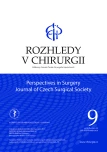Operační management pacienta po manuální repozici uskřinuté tříselné kýly: review
Authors:
B. East 1,2; J. Wolesky 1; B. Jisova 1; M. Pawlak 3; A. C. De Beaux 4; R. Lischke 1
Authors‘ workplace:
3rd Department of Surgery, 1st Faculty of Medicine, Charles University and University Hospital Motol, Prague
1; 2nd Faculty of Medicine, Charles University, Prague
2; Northern Devon Healthcare NHS Trust, Barnstaple
3; Department of General Surgery, Royal Infirmary of Edinburgh, Edinburgh
4
Published in:
Rozhl. Chir., 2020, roč. 99, č. 9, s. 380-383.
Category:
Review
doi:
https://doi.org/10.33699/PIS.2020.99.9.380–383
Overview
Úvod: Cílem sdělení je systematicky shrnout doposud publikovanou literaturu týkající se postupu u pacienta po manuální repozici uskřinuté tříselné kýly.
Metody: Analyzovali jsme dostupnou literaturu týkající se uskřinuté nebo strangulované tříselné kýly publikované do 31.3.2019. Z celkem 32 021 nalezených článků bylo k finální analýze použito 20.
Výsledky: Pojmy „uskřinutá“ a „strangulovaná“ byly v dohledaných publikacích používány zaměnitelně, nebylo tedy možné udělat analýzu jednotlivých skupin samostatně. Z doposud publikovaného se zdá, že je použití síťky ve srovnání s plastikou bez použití síťky stran recidivy výhodnější za cenu signifikantně vyššího počtu raných infekcí zejména ve skupině pacientů s nekrózou střeva. Laparoskopický přístup umožňuje vyhnout se zbytečné laparotomii a snížit tak výrazně morbiditu. Vyžaduje ale dostupnost laparoskopického vybavení a zkušenější chirurgický tým.
Závěr: Po manuální repozici uskřinuté tříselné kýly snižuje použití síťky počet recidiv, ale zvyšuje počet raných infekcí v závislosti na míře kontaminace. Pokud je k dispozici zkušený chirurgický tým a potřebné vybavení, laparoskopický přístup se zdá jako výhodnější zejména proto, že pomůže zabránit zbytečnému provedení laparotomie.
Klíčová slova:
tříselná kýla – uskřinutí – operace – laparoskopie – síťka – incarcerated
Sources
- East B, Pawlak M, de Beaux AC. A manual reduction of hernia under analgesia/sedation (Taxis) in the acute inguinal hernia: a useful technique in COVID-19 times to reduce the need for emergency surgery—a literature review. Hernia 2020 : 1−5. https://doi.org/10.1007/s10029-020-02227-1.
- Hernia Surge Group. International guidelines for groin hernia management. Hernia 2018;22(1):1−165. doi: 10.1007/s10029-017-1668-x.
- Romain B, Chemaly R, Meyer N, et al. Prognostic factors of postoperative morbidity and mortality in strangulated groin hernia. Hernia 2012;16(4):405−410. doi: 10.1007/s10029-012-0937-y.
- Kulah B, Duzgun AP, Moran M, et al. Emergency hernia repairs in elderly patients. Am J Surg. 2001;182(5):455−459. doi: 10.1016/s0002-9610(01)00765-6.
- Chen SC, Lee CC, Liu YP, et al. Ultrasound may decrease the emergency surgery rate of incarcerated inguinal hernia. Scand J Gastroenterol. 2005;40(6):721−724. doi: 10.1080/00365520510015485.
- Icoz G, Makay O, Sozbilen M, et al. Is D-dimer a predictor of strangulated intestinal hernia? World J Surg. 2006;30(12):2165−2169. doi: 10.1007/s00268-006-0138-x.
- Koizumi M, Sata N, Kaneda Y, et al. Optimal timeline for emergency surgery in patients with strangulated groin hernias. Hernia 2014;18(6):845−848. doi: 10.1007/s10029-014-1219-7.
- Sawayama H, Kanemitsu K, Okuma T, et al. Safety of polypropylene mesh for incarcerated groin and obturator hernias: a retrospective study of 110 patients. Hernia 2014;18(3):399−406. doi: 10.1007/s10029-013-1058-y.
- Brasso K, Løndal Nielsen K, et al. Long-term results of surgery for incarcerated groin hernia. Acta Chir Scand. 1989;155(11−12):583−585.
- Requarth W, Theis FV. Incarcerated and strangulated inguinal hernia; critical survey of 500 consecutive cases with treatment by nonsurgical, taxis, and surgical procedures. Arch Surg. 1948;57(2):267−275.
- Duan SJ, Qiu SB, Ding NY, et al. Prosthetic mesh repair in the emergency management of acutely strangulated groin hernias with grade I bowel necrosis: A rational choice. Am Surg. 2018;84(2):215−219.
- Bessa SS, Abdel-fattah MR, Al-Sayes IA, et al. Results of prosthetic mesh repair in the emergency management of the acutely incarcerated and/or strangulated groin hernias: a 10-year study. Hernia 2015;19(6):909−914. doi: 10.1007/s10029-015-1360-y.
- Hentati H, Dougaz W, Dziri C. Mesh repair versus non-mesh repair for strangulated inguinal hernia: systematic review with meta-analysis. World J Surg. 2014;38(11):2784−2790. doi: 10.1007/s00268-014-2710-0.
- Elsebae MM, Nasr M, Said M. Tension-free repair versus Bassini technique for strangulated inguinal hernia: A controlled randomized study. Int J Surg. 2008;6(4):302−305. doi: 10.1016/j.ijsu.2008.04.006.
- Yang L, Wang H, Liang X, et al. Bacteria in hernia sac: an important risk fact for surgical site infection after incarcerated hernia repair. Hernia 2015;19(2):279−283. doi: 10.1007/s10029-014-1275-z.
- Ram BR, Goud VS, Kumar DR, et al. Strangulated groin hernia repair: A new approach for all. J Clin Diagn Res. 2016;10(4):PC04−6. doi: 10.7860/JCDR/2016/18037.7613.
- Matsuda A, Miyashita M, Matsumoto S, et al. Laparoscopic transabdominal preperitoneal repair for strangulated inguinal hernia. Asian J Endosc Surg. 2018 ;11(2):155−159. doi: 10.1111/ases.12438.
- Topcu O, Kurt A, Soylu S, et al. Polypropylene mesh repair of incarcerated and strangulated hernias: a prospective clinical study. Surg Today 2013;43(10):1140−144. doi: 10.1007/s00595-012-0397-0.
- Deeba S, Purkayastha S, Paraskevas P, et al. Laparoscopic approach to incarcerated and strangulated inguinal hernias. JSLS 2009;13(3):327−331.
- Yang GP, Chan CT, Lai EC, et al. Laparoscopic versus open repair for strangulated groin hernias: 188 cases over 4 years. Asian J Endosc Surg. 2012;5(3):131−137. doi: 10.1111/j.1758-5910.2012.00138.x.
- White-Gittens IC, Kalabin A, Mani VR, et al. Hernioscopy in incarcerated inguinal hernia spontaneously reduced after general anesthesia induction. Cureus 2017;15;9(11):e1849. doi: 10.7759/cureus.1849.
- Tebala GD, Kola-Adejumo A, Yee J. Hernioscopy: a reliable method to explore the abdominal cavity in incarcerated or strangulated inguinal hernias spontaneously reduced after general anaesthesia. Hernia 2019;23(2):403−406. doi: 10.1007/s10029-019-01901-3
Labels
Surgery Orthopaedics Trauma surgeryArticle was published in
Perspectives in Surgery

2020 Issue 9
Most read in this issue
- Chirurgická léčba rozsáhlé perianální hidradenitidy
- Inkarcerovaná lumbálna hernia v oblasti trigonum Petiti ako príčina ileózneho stavu
- Změny normotermie během operačních výkonů
- Rozsáhlé poranění žlučových cest po laparoskopické cholecystektomii řešené tri-hepatikojejunoanastomózou na Y-Roux kličku: kazuistika
